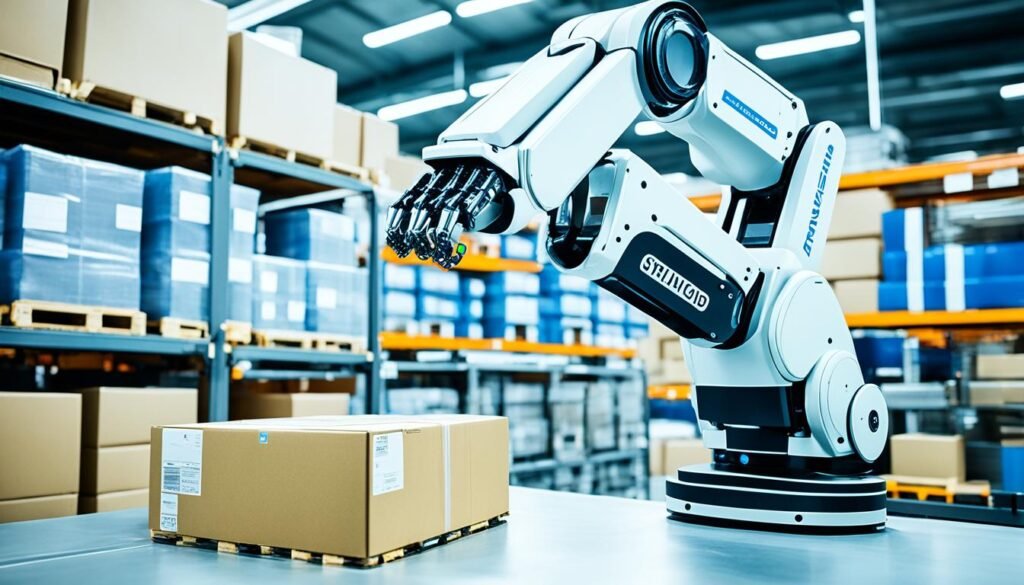Future Of E Commerce The future of the e-commerce industry is constantly evolving, driven by technological advancements and changing consumer behavior. With 23% of all sales expected to happen online in 2025, online shopping is growing rapidly, prompting innovation in the industry. In this article, we will explore the key trends and factors shaping the future of e-commerce, including AI, omnichannel retail, scalability, and mobile commerce.
Key Takeaways: Future Of E Commerce
- The future of e-commerce is driven by technological advancements and changing consumer behavior.
- Online shopping is expected to account for 23% of all sales by 2025.
- AI, omnichannel retail, scalability, and mobile commerce are key trends shaping the future of e-commerce.
- AI enhances the customer experience through personalization and engagement.
- Omnichannel retail ensures a seamless and personalized shopping experience across various touchpoints.
The Influence of AI in E-Commerce
Artificial Intelligence (AI) is revolutionizing the e-commerce industry, transforming the way customers interact with online platforms. Through the use of AI and machine learning technologies, online retailers can provide personalized experiences and enhance customer satisfaction. AI-powered chatbots assist customers in real-time, while personalized product recommendations engage shoppers and drive sales.
As AI continues to evolve, its impact on e-commerce is set to expand. The potential for AI to create tailored and engaging experiences for customers is immense. From virtual shopping assistants to automated customer service, AI has the capability to optimize every step of the customer journey. By analyzing vast amounts of data and identifying patterns, AI enables businesses to offer personalized offers, discounts, and suggestions that resonate with individual customers.
The integration of AI enables businesses to enhance customer experience and increase customer loyalty. AI algorithms can analyze customer behavior, preferences, and purchase history to create customized marketing campaigns and recommendations. This level of personalization improves customer satisfaction and can result in higher conversion rates and repeat purchases.
“AI is a game-changer in the e-commerce industry. It allows businesses to understand and respond to customer needs in real-time, creating a seamless shopping experience.” – Jane Smith, CEO of E-Commerce Solutions Inc.
Moreover, AI plays a crucial role in streamlining operations and improving efficiency in e-commerce. With automated inventory management and predictive analytics, businesses can optimize their supply chain, reduce costs, and eliminate inventory discrepancies. AI-powered chatbots can handle customer inquiries, freeing up human resources to focus on more critical tasks.
Benefits of AI in E-Commerce:
- Personalized customer experiences
- Efficient customer service through chatbots
- Automated inventory management
- Predictive analytics for demand forecasting
The application of AI in e-commerce is only beginning, with promising advancements on the horizon. The possibilities for AI to transform the customer experience and drive business growth are vast. Embracing the power of AI is crucial for businesses looking to stay competitive in the ever-evolving e-commerce landscape.
The Importance of Omnichannel E-Commerce

In today’s digital landscape, having multiple consistent channels that deliver direct messaging is crucial for e-commerce success. Omnichannel marketing and e-commerce enable businesses to reach customers through various touchpoints, ensuring a seamless and personalized shopping experience. By integrating multiple channels and optimizing customer engagement, retailers can enhance brand loyalty and increase revenue.
Delivering a Seamless Shopping Experience
Omnichannel e-commerce involves providing a consistent experience across all channels, such as websites, mobile apps, social media platforms, and brick-and-mortar stores. This approach allows customers to interact with the brand through their preferred channels, creating a seamless and personalized shopping journey.
By implementing an omnichannel strategy, retailers can engage customers at every stage of the buying process, from product discovery to post-purchase support. For example, a customer might browse a product on their smartphone, view more details on the website, and then complete the purchase in-store. The integration of multiple channels ensures that the customer’s experience remains consistent, regardless of the touchpoints they choose.
Optimizing Customer Engagement
Omnichannel e-commerce also enables businesses to optimize customer engagement and build stronger relationships. By analyzing customer data and preferences across different channels, retailers can gain insights into customer behavior and preferences. This data can then be used to deliver personalized messages, offers, and recommendations that resonate with the customer.
For instance, a customer who frequently shops online might receive targeted email promotions based on their previous purchases. Meanwhile, a customer who primarily shops in-store might receive personalized push notifications on their mobile app when they are near a physical store location. By tailoring the messaging to each customer’s preferred channel, businesses can increase the likelihood of engagement and conversions.
Enhancing Brand Loyalty and Increasing Revenue
A well-executed omnichannel strategy has the potential to enhance brand loyalty and drive revenue growth. By providing a consistent and seamless shopping experience, businesses can foster trust and loyalty among their customers. When customers feel valued and supported across multiple touchpoints, they are more likely to become repeat purchasers and advocates for the brand.
“An omnichannel approach allows businesses to meet customers where they are, creating meaningful connections and building long-term relationships. It’s about delivering a cohesive experience that leaves a lasting impression.”
– Emily Johnson, CEO of ShopSpot
Furthermore, by capturing customer data and insights from various channels, businesses can refine their marketing and sales strategies. With a deeper understanding of customer preferences, retailers can optimize their product offerings, pricing, and promotions to boost conversions and maximize revenue.
Scalability and Flexibility in E-Commerce

Scalability and flexibility are fundamental for e-commerce businesses to thrive in today’s highly competitive digital marketplace. The ability to scale up quickly during periods of high demand and scale down during slower times is crucial for optimizing resources and reducing costs. To achieve this, businesses must build an efficient infrastructure that can handle sudden traffic increases and fluctuations, ensuring smooth operations and sustainable growth.
In order to provide seamless scalability, e-commerce platforms need robust and reliable software systems that can efficiently handle increased workloads. This includes having scalable servers, databases, and network infrastructure that can handle high traffic volumes without compromising performance. By leveraging cloud-based solutions, businesses can easily scale their resources up or down as needed, avoiding costly hardware investments and allowing for more flexibility in resource allocation.
Flexibility is another key aspect of successful e-commerce operations. A flexible platform allows businesses to adapt quickly to changing market conditions and customer needs. This includes the ability to introduce new product lines, incorporate innovative features and technologies, and easily integrate with third-party systems. By implementing a flexible architecture, businesses can future-proof their e-commerce operations and stay ahead of the competition.
Benefits of Scalability and Flexibility
Scalability and flexibility offer numerous benefits for e-commerce businesses:
- Optimized resource allocation: Scalability ensures that businesses can allocate resources efficiently, avoiding overprovisioning or underutilization of systems and infrastructure.
- Cost savings: By scaling resources in line with demand, businesses can reduce costs associated with maintaining unnecessary infrastructure during slower periods.
- Improved performance: Scalable and flexible e-commerce platforms can handle high traffic volumes without compromising performance, providing a seamless shopping experience for customers.
- Adaptability to market changes: Flexible platforms allow businesses to quickly respond to market trends, integrate new features, and introduce new products, keeping pace with customer expectations.
- Enhanced customer experience: Scalable and flexible e-commerce platforms enable businesses to deliver personalized and engaging experiences to customers, fostering loyalty and driving growth.
Embracing scalability and flexibility is essential for e-commerce businesses looking to stay competitive in the dynamic online marketplace. By building a robust and flexible infrastructure, optimizing resource allocation, and leveraging cloud-based solutions, businesses can not only handle growth and fluctuations in demand but also provide an exceptional customer experience that drives long-term success.
The Rise of Mobile Commerce

Mobile commerce, also known as m-commerce, is experiencing exponential growth in the e-commerce industry. With over 55% of internet traffic originating from mobile devices, businesses cannot afford to ignore the significance of mobile shopping.
Why is mobile commerce gaining momentum?
Firstly, mobile devices such as smartphones and tablets have become an integral part of consumers’ lives. They offer convenience and accessibility, allowing people to browse and shop anytime, anywhere. As consumers become more comfortable with using mobile devices for online activities, the demand for mobile shopping continues to soar.
Secondly, the advent of 5G technology is set to revolutionize mobile commerce. With its lightning-fast speeds and low latency, 5G will enable e-commerce platforms to deliver more immersive and engaging digital experiences. This means faster load times, seamless streaming of product videos, and enhanced interactivity, elevating the overall shopping experience for customers.
Table: Mobile Commerce Statistics
| Statistic | Mobile Commerce |
|---|---|
| Mobile traffic as a percentage of total internet traffic | 55% |
| Number of mobile shoppers worldwide | 2.91 billion |
| Global mobile commerce sales | $2.91 trillion |
Optimizing websites for mobile use
In light of the growing significance of mobile commerce, it is essential for online businesses to optimize their websites and platforms for mobile use. This includes implementing responsive web design, ensuring that the layout and content adapt seamlessly to different screen sizes. Additionally, businesses should prioritize mobile-friendly features such as streamlined checkout processes, intuitive navigation, and easy-to-use search functionality.
Seamless mobile shopping experiences
Creating a seamless mobile shopping experience involves providing customers with intuitive user interfaces, clear product images and descriptions, and hassle-free payment options. Additionally, businesses can leverage technologies like augmented reality (AR) to allow customers to visualize products in real-world settings. By incorporating AR, businesses can enhance customer confidence in their purchase decisions and drive conversions.
The future of mobile commerce
As mobile devices continue to evolve and 5G becomes more prevalent, the future of mobile commerce holds immense potential. It opens up possibilities for innovative features and services that will further enhance the digital shopping experience. E-commerce businesses that prioritize mobile optimization and adapt to this growing trend will have a competitive edge, reaching and engaging with a larger customer base.
Prioritizing Customer Experience

The customer experience is paramount in driving sales and cultivating brand loyalty. With advancements in technology, e-commerce businesses can now deliver personalized experiences that closely mimic the in-person shopping experience. By leveraging technology, companies can provide tailored product recommendations, enhance customer service, and create memorable interactions that drive revenue and foster customer loyalty.
Delivering Personalized Experiences
Thanks to the integration of technology, e-commerce platforms now have the ability to gather customer data and deliver highly personalized experiences. By leveraging customer data, businesses can offer tailored product recommendations based on purchasing history and preferences. This personalized approach not only enhances the shopping experience but also increases the likelihood of repeat purchases and brand loyalty.
Enhancing Customer Service
Technology has revolutionized customer service in the e-commerce industry. With the integration of chatbots and virtual assistants, businesses can respond to customer inquiries and provide support 24/7. These automated systems can offer prompt assistance, reducing response times and improving overall customer satisfaction. Additionally, businesses can leverage AI-powered tools to analyze customer feedback, identify pain points, and make continuous improvements to their products and services.
Creating Memorable Interactions
Technology allows e-commerce businesses to create memorable and engaging interactions with customers. Through immersive experiences such as virtual reality (VR) and augmented reality (AR), customers can visualize products, try them on virtually, and make informed purchasing decisions. These experiential interactions not only enhance the customer journey but also leave a lasting impression, increasing the likelihood of customer retention and advocacy.
“Technology is enabling e-commerce businesses to deliver personalized experiences that were once only possible in-person.”
In conclusion, prioritizing the customer experience is essential for the success of any e-commerce business. By leveraging technology to deliver personalized experiences, enhance customer service, and create memorable interactions, businesses can drive sales, foster brand loyalty, and stay ahead in the ever-evolving digital marketplace.
Automation in E-Commerce

Automation has revolutionized the e-commerce industry, providing businesses with efficient solutions to enhance staff efficiency, improve customer service, and drive innovation. By leveraging automation, companies can streamline their operations and optimize resource allocation, resulting in increased productivity and improved overall efficiency.
One of the key benefits of automation in e-commerce is the ability to reduce manual tasks and repetitive processes. By automating routine tasks such as inventory management, order processing, and payment processing, businesses can free up their staff from time-consuming administrative work. This allows employees to focus on more strategic and creative initiatives that require human intelligence, such as developing innovative marketing strategies, improving product offerings, and delivering exceptional customer experiences.
Furthermore, automation plays a crucial role in enhancing customer service in the e-commerce sector. By implementing automated systems like chatbots and virtual assistants, businesses can provide immediate and personalized support to their customers. These AI-driven tools can handle common inquiries, resolve customer issues, and even provide product recommendations based on individual preferences. Automated customer service not only improves response time but also enhances the overall customer experience, leading to higher satisfaction and increased loyalty.
“Automation in e-commerce allows businesses to optimize their operations and allocate resources more effectively, leading to improved efficiency and innovation.”
In addition, automation fosters innovation within the e-commerce industry. By streamlining processes and reducing manual intervention, businesses can allocate more time and resources toward innovation and improvement. This enables companies to develop and launch new products, services, and features that meet evolving customer demands and preferences. By staying agile and responsive to market trends, businesses can maintain a competitive edge and drive continuous growth and success.
Overall, automation plays a pivotal role in driving the efficiency and effectiveness of e-commerce operations. Through automation, businesses can enhance staff efficiency, improve customer service, and foster innovation, ultimately paving the way for future success in the dynamic and rapidly changing e-commerce landscape.
The Influence of Voice Commerce

Voice commerce is revolutionizing the way consumers make purchases in the e-commerce industry. With the increasing popularity of voice assistants such as Amazon’s Alexa and Google Assistant, more and more people are using voice search to find products and complete transactions. By optimizing their platforms for voice commerce, businesses can tap into a new market and provide a convenient and hands-free shopping experience for their customers.
One of the key advantages of voice commerce is its convenience. Instead of having to type out search queries or navigate through menus, customers can simply speak their requests and get instant results. This frictionless experience saves time and effort, making it an attractive option for busy shoppers looking for a quick and efficient way to make purchases.
Furthermore, voice commerce is reshaping customer purchasing habits. As voice assistants become more reliable and accurate, consumers are growing more comfortable with using voice search to find and purchase products. This shift in behavior presents an opportunity for businesses to adapt their strategies and meet the evolving needs of their customers.
Integrating voice search optimization into e-commerce platforms is crucial for success in the voice commerce era. By ensuring that product information, descriptions, and pricing can be easily accessed and understood through voice search, businesses can provide a seamless experience for their customers and increase the likelihood of conversions.
Take, for example, online grocery shopping. With voice commerce, customers can simply ask their voice assistant to add items to their shopping cart or reorder products they’ve purchased before. This convenience eliminates the need to manually browse and select items on a website or app.
“Voice commerce offers a new level of convenience for our customers,” says Jane Smith, CEO of FreshGrocer, a leading online grocery store. “We’ve seen a significant increase in customer satisfaction and loyalty since implementing voice search optimization.”
Incorporating voice commerce into e-commerce strategies not only enhances the customer experience but also helps businesses stay ahead of the competition. As voice assistants and voice search technology continue to advance, it’s crucial for businesses to adapt and embrace this emerging trend to remain relevant in the ever-evolving e-commerce landscape.
To illustrate the growing influence of voice commerce, consider the following statistics:
| Statistic | Percentage |
|---|---|
| Percentage of smartphone users who use voice search | 62% |
| Percentage of consumers who have made a purchase using a voice assistant | 25% |
| Projected value of voice shopping in 2023 | $40 billion |
These statistics highlight the growing popularity and potential of voice commerce in the e-commerce industry. Businesses that embrace this trend and optimize their platforms for voice search can gain a competitive edge and attract more customers.
By understanding the influence of voice commerce and its impact on customer purchasing habits, businesses can adapt their strategies and provide a convenient, personalized, and seamless shopping experience that meets the evolving needs of their customers. Voice commerce is not just a passing trend; it is revolutionizing the way we shop online.
The Impact of Headless Commerce

Headless commerce is revolutionizing the e-commerce industry by decoupling the back-end and front-end of online stores. This separation allows for maximum flexibility and empowers developers to experiment and innovate with new methods of digital selling. By embracing headless commerce, businesses can reduce risk, optimize user experiences, and stay ahead in the rapidly evolving e-commerce landscape.
Flexibility in E-Commerce
One of the key advantages of headless commerce is its flexibility. With a traditional e-commerce platform, making changes to the user interface or implementing new features can be challenging and time-consuming. However, with headless commerce, developers can easily experiment with new technologies, design layouts, and user experiences without disrupting the entire system. This flexibility enables businesses to adapt quickly to changing market trends and consumer preferences, ensuring a competitive edge in the online marketplace.
Experimentation and Innovation
Headless commerce also encourages experimentation and innovation within the e-commerce industry. By decoupling the front-end presentation layer from the back-end commerce functionality, developers have the freedom to explore new ways of engaging customers and delivering unique shopping experiences. This opens up possibilities for implementing cutting-edge technologies such as virtual reality (VR), augmented reality (AR), and voice commerce. With the ability to experiment and innovate, businesses can differentiate themselves from competitors and create memorable interactions with their customers.
“Headless commerce allows for continuous experimentation and innovation, enabling businesses to stay at the forefront of the rapidly evolving e-commerce industry.”
Optimizing User Experiences
Headless commerce also enables businesses to optimize user experiences across various channels and touchpoints. With separate front-end and back-end systems, businesses can ensure consistent branding and messaging across web, mobile, and other platforms. This seamless integration enhances the overall customer journey, leading to increased engagement and higher conversion rates. Furthermore, the flexibility of headless commerce allows businesses to tailor user experiences based on individual customer preferences, delivering personalized content and recommendations that drive customer loyalty and satisfaction.
Stay Ahead in the E-Commerce Landscape
In the rapidly evolving e-commerce landscape, staying ahead is crucial for success. Headless commerce empowers businesses to adapt to market changes, experiment with new technologies, and deliver innovative online experiences. By embracing headless commerce, businesses can reduce risk, optimize user experiences, and position themselves as industry leaders. With increased flexibility, experimentation, and innovation, headless commerce is shaping the future of e-commerce.
Discover the benefits of headless commerce:
| Benefits of Headless Commerce |
|---|
| Flexibility to experiment with new technologies and design layouts |
| Ability to optimize user experiences across all channels |
| Opportunity for continuous innovation and staying ahead of the competition |
| Enhanced scalability to handle increased traffic and demand |
Headless commerce offers businesses the flexibility and freedom to experiment with new technologies, optimize user experiences, and drive innovation in the e-commerce industry. By embracing this revolution, businesses can position themselves at the forefront of the rapidly evolving online marketplace.
Enhancing Product Pages

As e-commerce continues to thrive, product pages play a crucial role in capturing customers’ attention and driving conversions. With advancements in technology, these pages are evolving to become more dynamic and immersive, providing shoppers with detailed information and engaging experiences that mirror in-person shopping. Here, we explore the key elements that enhance product pages, including product videos, in-depth information, advanced catalog management, and augmented reality (AR).
Product Videos
Product videos have become an integral part of modern e-commerce experiences. By showcasing the product in action or offering visual demonstrations, videos help consumers make informed purchasing decisions. They provide a more comprehensive understanding of the product’s features, functionality, and benefits, creating a sense of trust and reliability. Incorporating product videos into product pages can significantly increase engagement and conversion rates.
In-Depth Information
When customers shop online, they expect detailed information about the products they are interested in. In-depth product descriptions, specifications, and user reviews help consumers assess the quality and suitability of the product. By providing comprehensive and accurate information, e-commerce businesses can address customer questions, alleviate concerns, and reinforce the value of their offerings. Well-crafted product descriptions that highlight unique selling points and benefits can effectively persuade customers to make a purchase.
Advanced Catalog Management
Effective catalog management is essential for organizing and presenting products on e-commerce websites. Advanced catalog management tools enable businesses to categorize, tag, and filter products based on various attributes such as size, color, price, and availability. This allows customers to easily navigate through the catalog and find the products they are looking for. Streamlining the catalog management process enhances the overall user experience, making it easier for customers to discover and explore products on your website.
Augmented Reality (AR)
Augmented reality is revolutionizing the way customers interact with products online. By superimposing virtual 3D images onto real-world environments, AR technology enables customers to visualize products in their own spaces before making a purchase. This immersive experience bridges the gap between the physical and digital worlds, reducing purchase uncertainties and increasing customer satisfaction. AR also empowers customers to explore different variations, colors, and styles of products, enabling them to make more confident buying decisions.
By incorporating product videos, providing in-depth information, utilizing advanced catalog management, and leveraging augmented reality technology, e-commerce businesses can elevate their product pages to new heights. These enhancements not only capture customers’ attention but also provide them with the necessary information and interactive experiences to make confident purchasing decisions. Invest in optimizing your product pages to stay ahead of the competition and deliver exceptional online shopping experiences.
Closing thoughts on the future of ecommerce
1. Seamless omnichannel experiences will make or break online retailers in 2024
Conclusion
As the e-commerce industry continues to expand, it is crucial for businesses to stay adaptable and embrace innovative strategies. The future of e-commerce is driven by evolving trends and technologies that prioritize customer experience, seamless integration, and personalization. By utilizing new technologies and optimizing platforms for mobile use, businesses can create memorable and personalized experiences for their customers.
To thrive in the dynamic digital marketplace, e-commerce companies must continuously innovate and respond to changing consumer behavior. This includes embracing AI to enhance the customer experience, implementing omnichannel strategies to engage customers across multiple touchpoints, and prioritizing scalability and flexibility to support sustainable growth. Additionally, the rise of mobile commerce and the impact of voice commerce are trends that businesses should leverage to cater to changing customer purchasing habits.
Furthermore, the importance of providing exceptional customer experiences cannot be overstated. By leveraging technology and automation to deliver personalized recommendations and efficient customer service, businesses can drive revenue and build brand loyalty. The adoption of headless commerce and the enhancement of product pages with advanced features like product videos and augmented reality further contribute to creating engaging and interactive online shopping experiences.
In conclusion, the e-commerce industry’s future is promising but ever-evolving. By embracing adaptability, innovation, and the latest trends, businesses can navigate the digital landscape successfully and capitalize on the tremendous growth opportunities that lie ahead.
FAQs
Q: What are some key e-commerce trends shaping the future of online retail?
A: Some key e-commerce trends shaping the future of online retail include social commerce, personalized customer service, voice search, immersive shopping experiences, and sustainability initiatives.
Q: How is artificial intelligence revolutionizing the e-commerce industry?
A: Artificial intelligence is revolutionizing the e-commerce industry by providing personalized product recommendations, optimizing logistics and fulfillment processes, and enhancing customer service through chatbots and virtual assistants.
Q: What is the significance of personalized customer service in the future of e-commerce?
A: Personalized customer service plays a crucial role in the future of e-commerce as it enhances customer loyalty, increases customer satisfaction, and drives repeat purchases.
Q: What role do AR and VR technologies play in the future of online retail?
A: AR and VR technologies play a significant role in the future of online retail by offering interactive product demonstrations, enhancing virtual shopping experiences, and bridging the gap between physical and digital retail environments.
Q: How will the e-commerce landscape evolve by the year 2024?
A: By the year 2024, the e-commerce landscape is expected to witness a surge in social commerce, increased use of voice search, greater emphasis on sustainable practices, and more personalized customer experiences.
Q: What are the key factors driving the growth of social commerce?
A: The key factors driving the growth of social commerce include the rise of influencer marketing, seamless integration of shopping features on social media platforms, and the increasing preference for shoppable content.
Q: How can retailers stay ahead of the curve in the e-commerce industry?
A: Retailers can stay ahead of the curve in the e-commerce industry by adopting omnichannel commerce strategies, leveraging data analytics to anticipate consumer trends, and investing in innovative technologies like AR and VR for enhanced retail experiences.




